
Hoplites were citizen-soldiers of Ancient Greek city-states who were primarily armed with spears and shields. Hoplite soldiers used the phalanx formation to be effective in war with fewer soldiers. The formation discouraged the soldiers from acting alone, for this would compromise the formation and minimize its strengths. The hoplites were primarily represented by free citizens – propertied farmers and artisans – who were able to afford a linen or bronze armour suit and weapons. It also appears in the stories of Homer, but it is thought that its use began in earnest around the 7th century BC, when weapons became cheap during the Iron Age and ordinary citizens were able to provide their own weapons. Most hoplites were not professional soldiers and often lacked sufficient military training. Some states maintained a small elite professional unit, known as the epilektoi or logades since they were picked from the regular citizen infantry. These existed at times in Athens, Sparta, Argos, Thebes, and Syracuse, among other places. Hoplite soldiers made up the bulk of ancient Greek armies.

A pike is a long thrusting spear formerly used in European warfare from the Late Middle Ages and most of the early modern period, and were wielded by foot soldiers deployed in pike square formation, until it was largely replaced by bayonet-equipped muskets. The pike was particularly well known as the primary weapon of Swiss mercenary, German Landsknecht units and French sans-culottes. A similar weapon, the sarissa, had been used in antiquity by Alexander the Great's Macedonian phalanx infantry.

The Battle of Pydna took place in 168 BC between Rome and Macedon during the Third Macedonian War. The battle saw the further ascendancy of Rome in the Hellenistic world and the end of the Antigonid line of kings, whose power traced back to Alexander the Great. The battle is also considered to be a victory of the Roman legion's manipular system's flexibility over the Macedonian phalanx's rigidity.

A peltast was a type of light infantry originating in Thrace and Paeonia and named after the kind of shield he carried. Thucydides mentions the Thracian peltasts, while Xenophon in the Anabasis distinguishes the Thracian and Greek peltast troops.

The Companions were the elite cavalry of the Macedonian army from the time of King Philip II of Macedon, achieving their greatest prestige under Alexander the Great, and regarded as the first or among the first shock cavalry used in Europe. Chosen Companions, or Hetairoi, formed the elite guard of the king (Somatophylakes).

A tercio, Spanish for "[a] third") was a military unit of the Spanish Army during the reign of the Catholic Monarchs and the Spanish Habsburgs in the early modern period. They were the elite military units of the Spanish Monarchy and the essential pieces of the powerful land forces of the Spanish Empire, sometimes also fighting with the navy. The Spanish tercios were one of the finest professional infantries in the world due to the effectiveness of their battlefield formations and were a crucial step in the formation of modern European armies, made up of professional volunteers, instead of levies raised for a campaign or hired mercenaries typically used by other European countries of the time.

The sarissa or sarisa was a long spear or pike about 5 to 7 meters in length. It was introduced by Philip II of Macedon and was used in his Macedonian phalanxes as a replacement for the earlier dory, which was considerably shorter. These longer spears improved the strength of the phalanx by extending the rows of overlapping weapons projecting towards the enemy. After the conquests of Alexander the Great, the sarissa was a mainstay during the Hellenistic era by the Hellenistic armies of the diadochi Greek successor states of Alexander's empire, as well as some of their rivals.
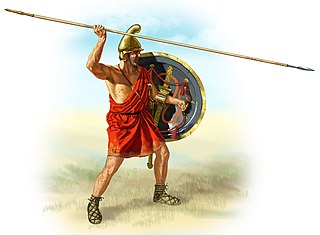
A hypaspist is a squire, man at arms, or "shield carrier". In Homer, Deiphobos advances "ὑπασπίδια" or under cover of his shield. By the time of Herodotus (426 BC), the word had come to mean a high status soldier as is strongly suggested by Herodotus in one of the earliest known uses:
Now the horse which Artybius rode was trained to fight with infantrymen by rearing up. Hearing this, Onesilus said to his hypaspist, a Carian of great renown in war and a valiant man ...
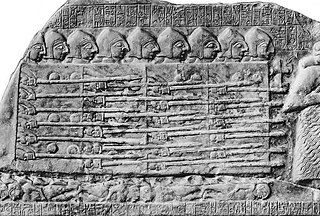
The phalanx was a rectangular mass military formation, usually composed entirely of heavy infantry armed with spears, pikes, sarissas, or similar pole weapons tightly packed together. The term is particularly used to describe the use of this formation in ancient Greek warfare, although the ancient Greek writers used it to also describe any massed infantry formation, regardless of its equipment. Arrian uses the term in his Array against the Alans when he refers to his legions. In Greek texts, the phalanx may be deployed for battle, on the march, or even camped, thus describing the mass of infantry or cavalry that would deploy in line during battle. They marched forward as one entity.
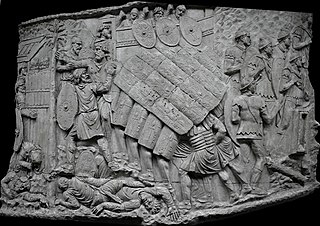
In ancient Roman warfare, the testudo or tortoise formation was a type of shield wall formation commonly used by the Roman legions during battles, particularly sieges.

A pavise was an oblong shield used during the mid-14th to early 16th centuries. Often large enough to cover the entire body, it was used by archers, crossbowmen, and other infantry soldiers on the battlefield.

The army of the Kingdom of Macedon was among the greatest military forces of the ancient world. It was created and made formidable by King Philip II of Macedon; previously the army of Macedon had been of little account in the politics of the Greek world, and Macedonia had been regarded as a second-rate power.
The pezhetairoi were the backbone of the Macedonian army and Diadochi kingdoms. They were literally "foot companions".
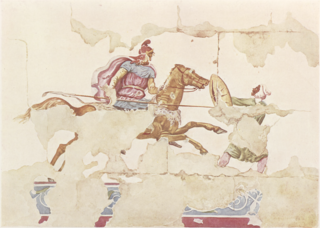
The sarissophoroi, also called prodromoi, were a unit of light cavalry in the ancient Macedonian army.
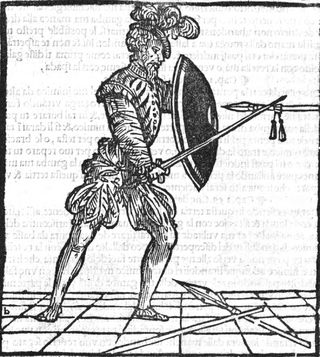
Rodeleros, also called espadachines ("swordsmen") and colloquially known as "Sword and Buckler Men", were Spanish troops in the early 16th century, equipped with steel shields known as rodela and swords . Originally conceived as an Italian attempt to revive the legionary swordsman, they were adopted by the Spanish and used with great efficiency in the Italian Wars during the 1510s and 1520s, but discontinued in the 1530s.
The Hellenistic armies is a term which refers to the various armies of the successor kingdoms to the Hellenistic period, emerging soon after the death of Alexander the Great in 323 BCE, when the Macedonian empire was split between his successors, known as the Diadochi.

Despite the rise of knightly cavalry in the 11th century, infantry played an important role throughout the Middle Ages on both the battlefield and in sieges. From the 14th century onwards, it has been argued that there was a rise in the prominence of infantry forces, sometimes referred to as an "infantry revolution", but this view is strongly contested by some military historians based High Medieval practice.
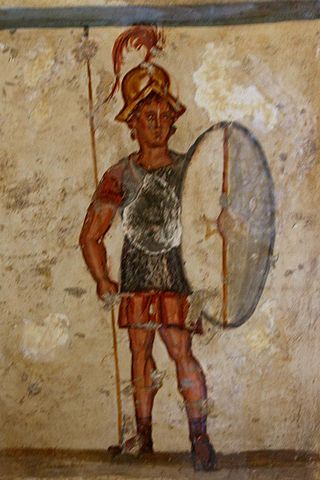
The Antigonid Macedonian army was the army that evolved from the ancient Greek kingdom of Macedonia in the period when it was ruled by the Antigonid dynasty from 276 BC to 168 BC. It was seen as one of the principal Hellenistic fighting forces until its ultimate defeat at Roman hands at the Battle of Pydna in 168 BC. However, there was a brief resurgence in 150-148 during the revolt of Andriscus, a supposed heir to Perseus.

The hippika gymnasia were ritual tournaments performed by the cavalry of the Roman Empire to both practice their skills and display their expertise. They took place on a parade ground situated outside a fort and involved the cavalry practicing manoeuvring and the handling of weapons such as javelins and spears. The riders and their mounts wore highly elaborate armour and helmets specially made for display purposes, decorated with images from classical mythology. Such tournaments served several purposes, improving the riders' skills, helping to build unit morale and impressing dignitaries and conquered peoples.

The Macedonian phalanx was an infantry formation developed by Philip II from the classical Greek phalanx, of which the main innovation was the use of the sarissa, a 6-metre pike. It was famously commanded by Philip's son Alexander the Great during his conquest of the Achaemenid Empire between 334 and 323 BC. The Macedonian phalanx model then spread throughout the Hellenistic world, where it became the standard battle formation for pitched battles. During the Macedonian Wars against the Roman Republic, the phalanx appeared obsolete against the more manoeuvrable Roman legions.















